Social Selling in 2023: Everything You Need to Know
Casey O'Connor
Contents
- What Is Social Selling?
- The Benefits of Social Selling
- The Best Networks for Social Selling
- Social Selling Strategies
- How to Get Started Social Selling
- How to Optimize Your Social Profiles for Social Selling
- Best Practices for Social Selling On LinkedIn
- Best Practices for Social Selling On Twitter
- Best Practices for Social Selling On Facebook
- How to Measure Social Selling Success
- Tools for Social Selling
- Social Selling Mistakes to Avoid
Social selling is an approach to the sales process that leverages the power of social media. Effective social selling can help salespeople:
- Optimize their outreach process for faster connections with their target audience
- Provide highly relevant content to potential customers at critical moments in the buying journey
- Build relationships that lead to lucrative sales opportunities and referrals
Be aware, though: social selling is decidedly not simply spouting off the team sales pitch on LinkedIn or Facebook. This sales strategy is more nuanced than that and requires some tact and finesse.
In this article, we compiled the best social selling research and strategies so that your sales team can start adopting this profitable sales approach.
Here’s what we’ll cover:
- What Is Social Selling?
- The Benefits of Social Selling
- The Best Networks for Social Selling
- Social Selling Strategies
- How to Get Started Social Selling
- How to Optimize Your Social Profiles
- Best Practices for Social Selling On LinkedIn
- Best Practices for Social Selling On Twitter
- Best Practices for Social Selling On Facebook
- How to Measure Social Selling Success
- Tools for Social Selling
- Social Selling Mistakes to Avoid
What Is Social Selling?
Social selling is kind of an umbrella term — it’s a catch-all for the many ways in which a sales (and sometimes marketing) team leverages their social media platforms in order to:
- Make authentic, natural connections with the right prospects
- Become thought leaders in their industry by sharing content that’s valuable and timely
- Develop value-based, trusting relationships with potential clients
It’s a sales strategy that’s being used more and more, and for good reason. And the proof is in the pudding. The data is loud and clear: 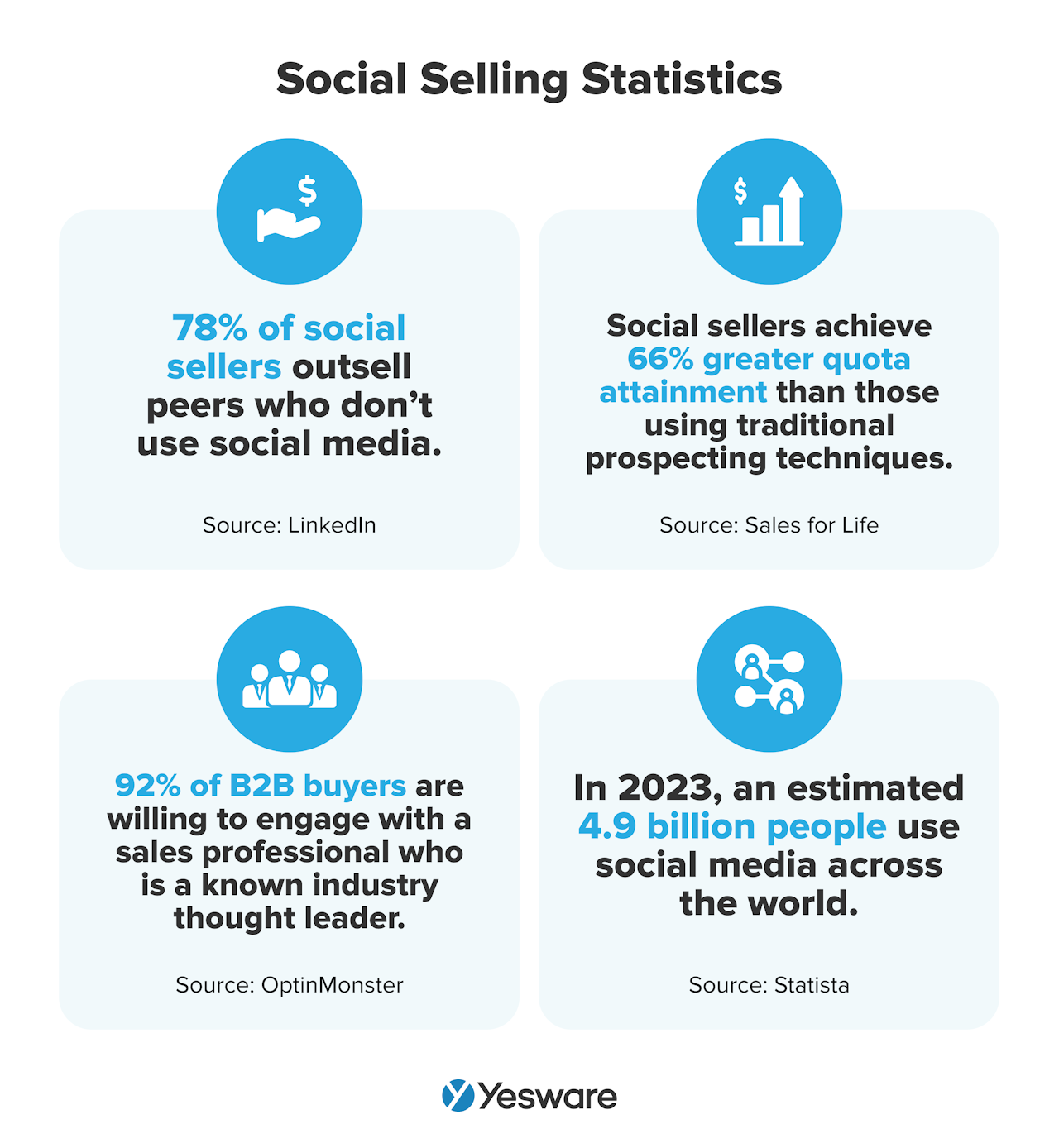 But be warned: a lot of salespeople get the wrong idea about what social selling actually looks like. It’s not as simple as making a profile on LinkedIn or Facebook and waiting for the sales to roll in.
But be warned: a lot of salespeople get the wrong idea about what social selling actually looks like. It’s not as simple as making a profile on LinkedIn or Facebook and waiting for the sales to roll in.
Social sellers use a complex combination of strategies and tools that enable them to leverage the power of their social networks to learn targeted information about their customers’ pain points. This information, in turn, helps the company tailor their social media marketing efforts around those pain points.
In other words, it allows salespeople to authentically offer the right value to the right prospects at the right time.
If it sounds a little bit like magic, it’s because it kind of is. Effective social selling requires a delicate balance of technology and human touch, and buyers will know if your efforts aren’t genuine. But when the pieces come together the right way, effective social selling can earn salespeople the right to be a fly on the wall of their potential clients (without the ick factor).
Social selling allows salespeople to (politely!) “listen in” on their prospects’ conversations on social media, and put their best foot forward accordingly.
The Benefits of Social Selling
As an everyday consumer, the idea of social selling may seem a bit intrusive. It can be creepy to think about how much LinkedIn or Facebook really know about us. But most people in B2B sales know that this kind of buyer/seller interaction happens behind the scenes all the time on social media.
Despite sounding a bit “Big Brother,” social selling is actually a powerful sales strategy that ultimately builds trust — and trust is what ultimately leads people to make purchases.
And it’s not just another sales trend — we’re willing to bet that social selling is here to stay. That’s because it works. Nearly every sales metric and KPI gets better when social selling is involved. Let’s look at some of the benefits below. 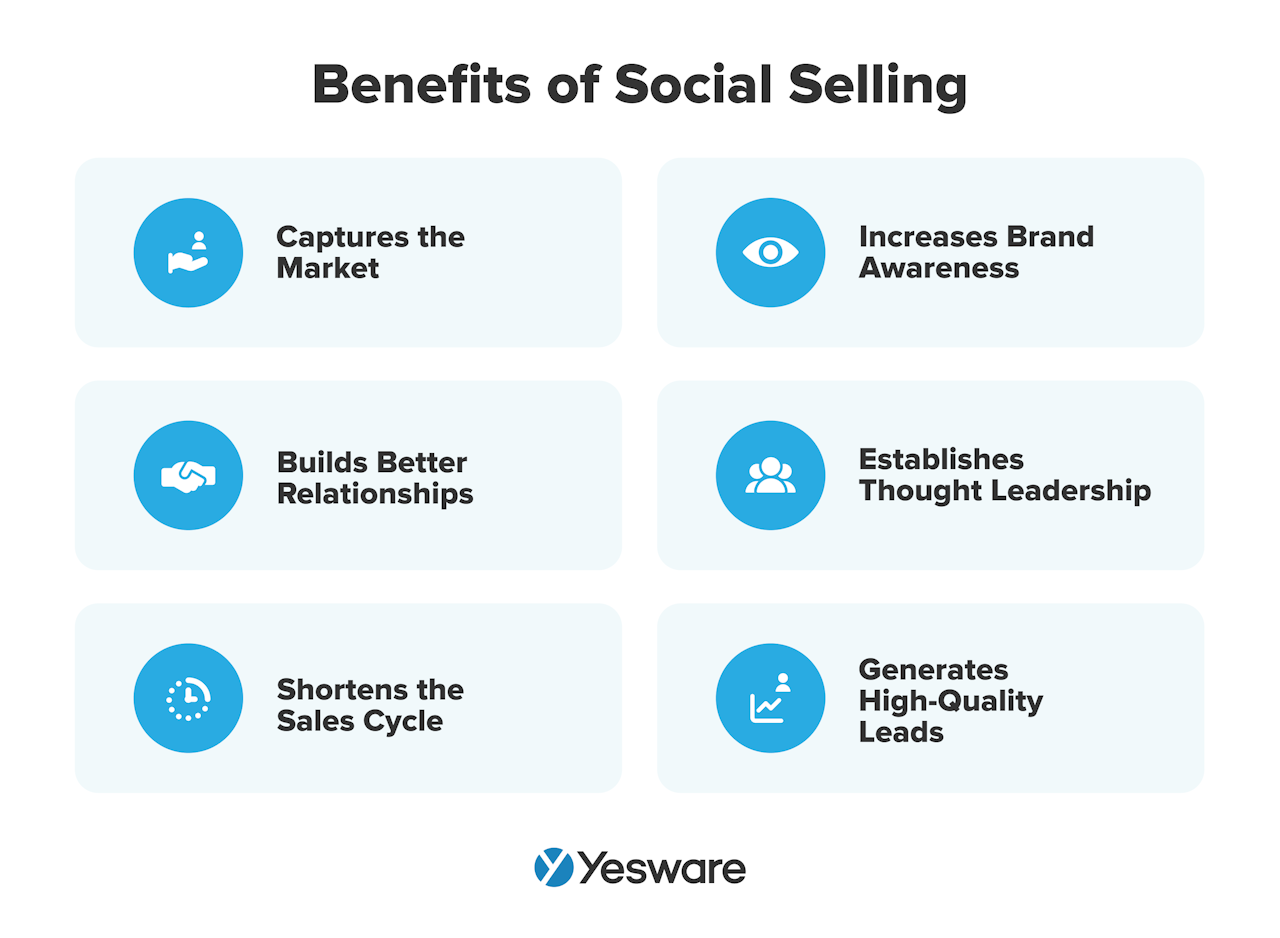
1. Capture the Market
Social selling is becoming increasingly popular as more and more companies use social media to help them make purchasing decisions. In fact, 75% of B2B buyers and a whopping 84% of C-level decision-makers use social media as part of their purchasing process.
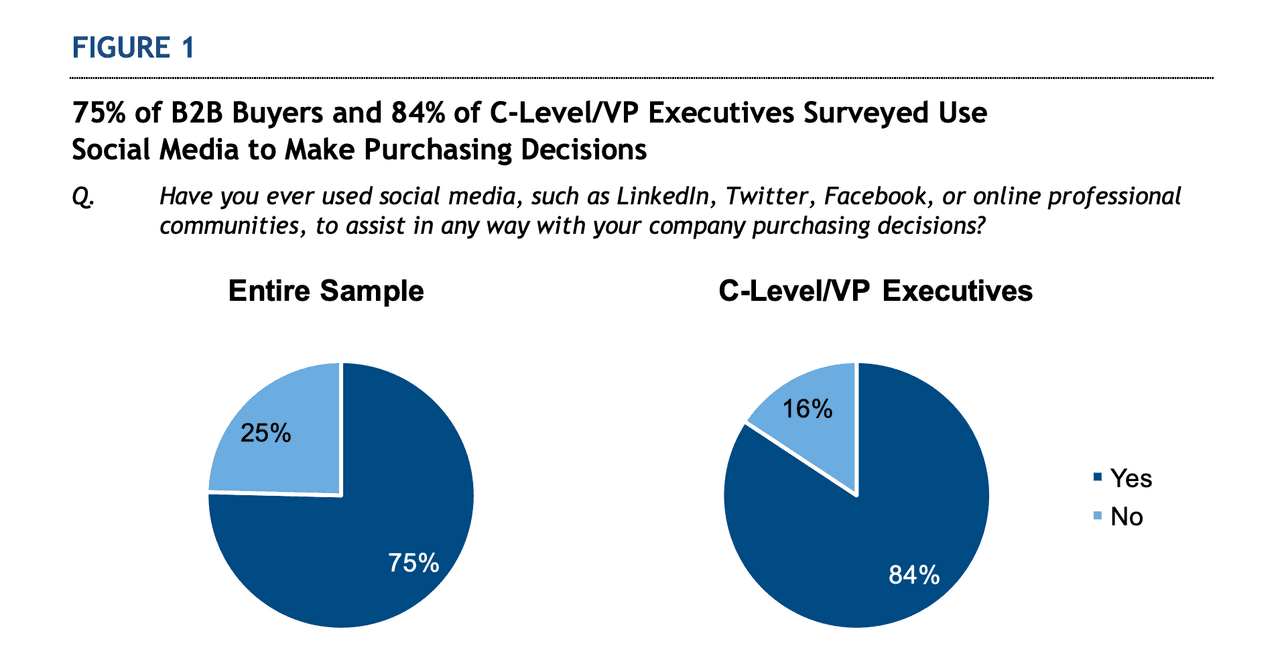
And those numbers are only going to go up from there. A recent Google study shows that millennials — represented by the blue bubble in the graphic below — are quickly becoming the largest share of B2B researchers and increasingly taking over positions of upper-level decision-makers.
Do you know what else millennials are really good at?
Social media.
The more millennials move into B2B sales decision-making positions, the more prevalent and important social selling will become. That means that the sooner your sales team leverages their own social media presence, the better chance your company has to capture that market share as the sales landscape continues to change.
2. Build Better Relationships
The truth is, buyers don’t really care what sales approach you take. Whether you’re a proponent or value selling, consultative sales, or even a more traditional approach, know this: at the end of the day, customers buy from one kind of sales rep — the one they trust.
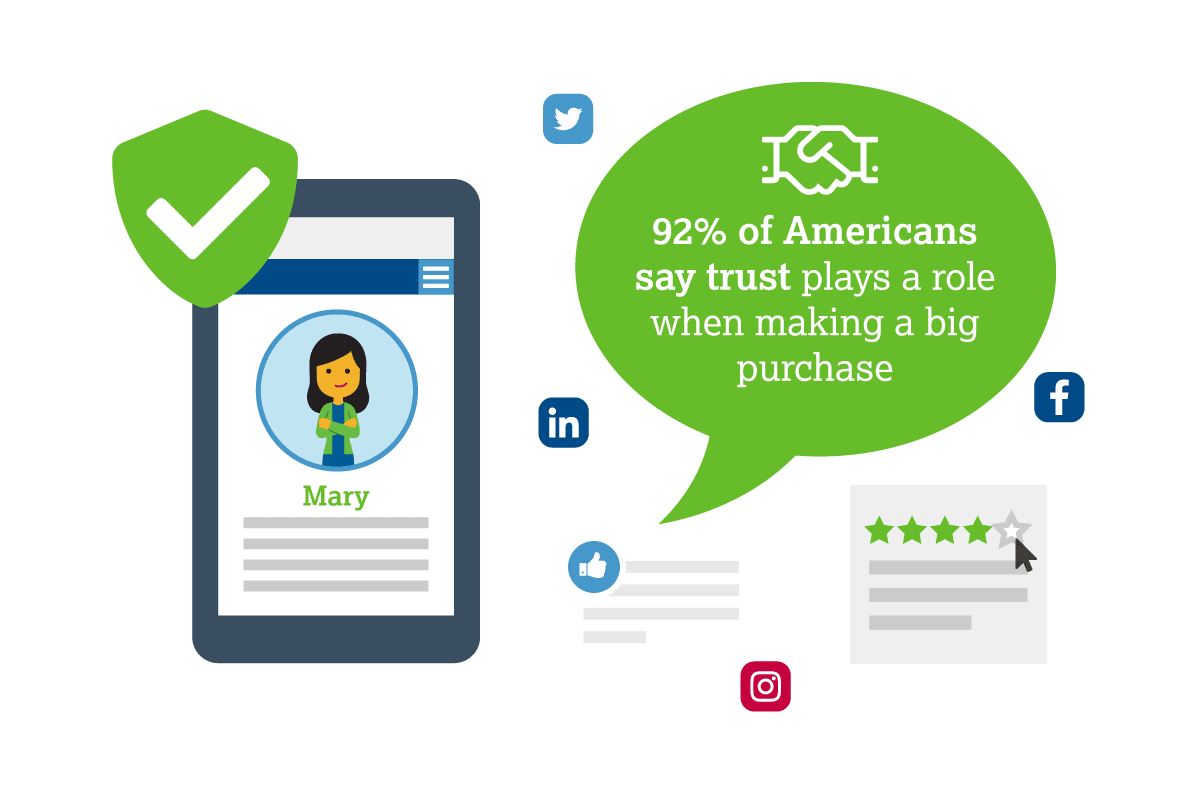 That’s one reason that social selling is so effective. When executed correctly, social selling is a fantastic way for businesses to organically demonstrate the value they can offer. And because social selling leverages the power of your existing social network, there’s usually some trust already baked into the process.
That’s one reason that social selling is so effective. When executed correctly, social selling is a fantastic way for businesses to organically demonstrate the value they can offer. And because social selling leverages the power of your existing social network, there’s usually some trust already baked into the process.
The combination of familiarity (via social networks) + a highly targeted value offering (gleaned from social listening, which we’ll get to in a minute) is a powerful tool that allows salespeople to build solid, trusting relationships with potential clients.
All this to say: gone are the days of awkward cold calls and outbound marketing. Social selling changes the game — get ready for a pipeline of warm leads, straight from your target audience and ready to connect.
3. Shortens the Sales Cycle
Today’s B2B buyer is more than halfway through the research process by the time they reach out to a sales rep.
Social selling can help sales reps place themselves in the right place at the right time, so they can cut down on the time it takes to make contact. It puts your brand directly in front of the buyer at the exact time they’re seeking information. This positional advantage can be pivotal in shortening the sales cycle.
Effective social selling also helps your organization stand out as a leader in the industry. A strong social media profile that makes your company look like a trusted expert can go a long way in reducing deliberation time for buyers.
4. Increases Brand Awareness
Most marketers know that one of the best ways to improve brand awareness is through effective social media marketing.
In fact, that’s why most marketers gravitate toward this strategy in the first place.
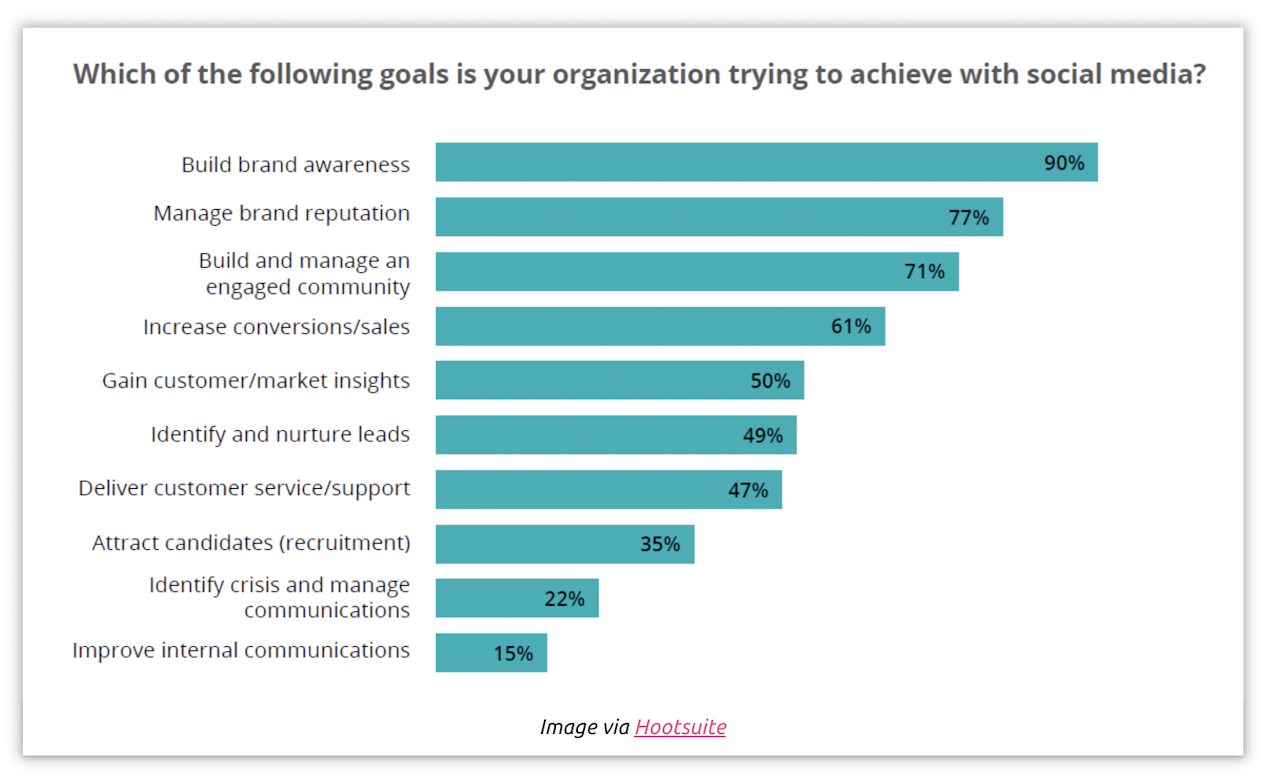
It should come as no surprise that the more visible and active your brand is on social media (i.e., you regularly update your optimized profile by sharing lots of high-value content), the more people will become aware of what your brand is all about. Social selling is a fantastic tool for increasing brand awareness.
5. Establishes Thought Leadership
Although “thought leadership” sounds perhaps too nebulous to be critical to the sales process — it’s a bit of a “you know it when you see it” kind of thing — the fact is that today’s B2B buyer looks more and more for a credible online presence that consistently and confidently offers value within their industry. 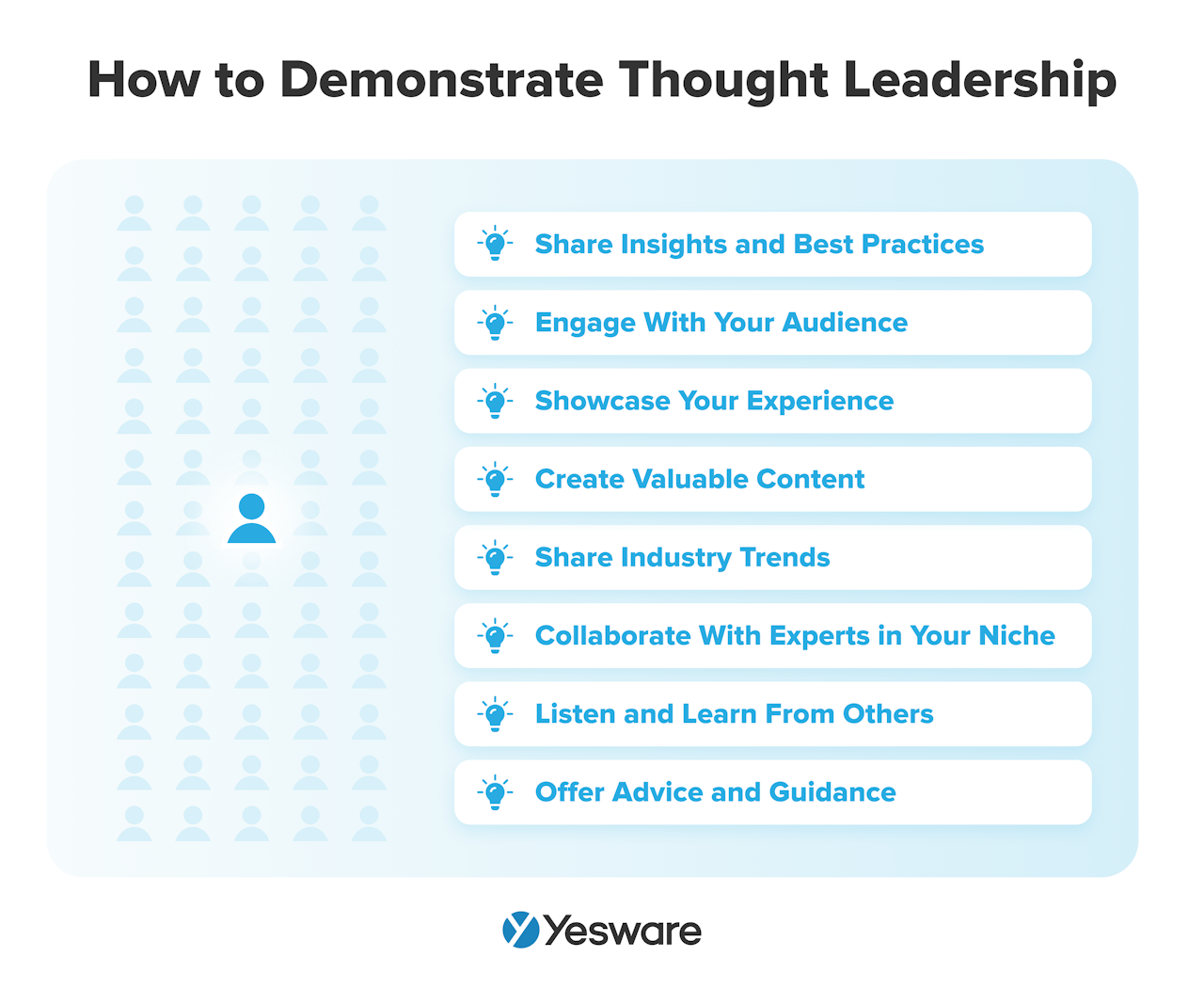 Social selling is the perfect vehicle to develop your company’s presence as a thought leader in your industry.
Social selling is the perfect vehicle to develop your company’s presence as a thought leader in your industry.
Use your social media platforms to share and generate conversation around high-value, shareable content, answer questions in a timely manner, and (subtly) show off any relevant progress and success.
6. Generates High-Quality Leads
With nearly 5 billion current users (and the number expected to grow by another near billion by 2027), social media is a goldmine of leads.
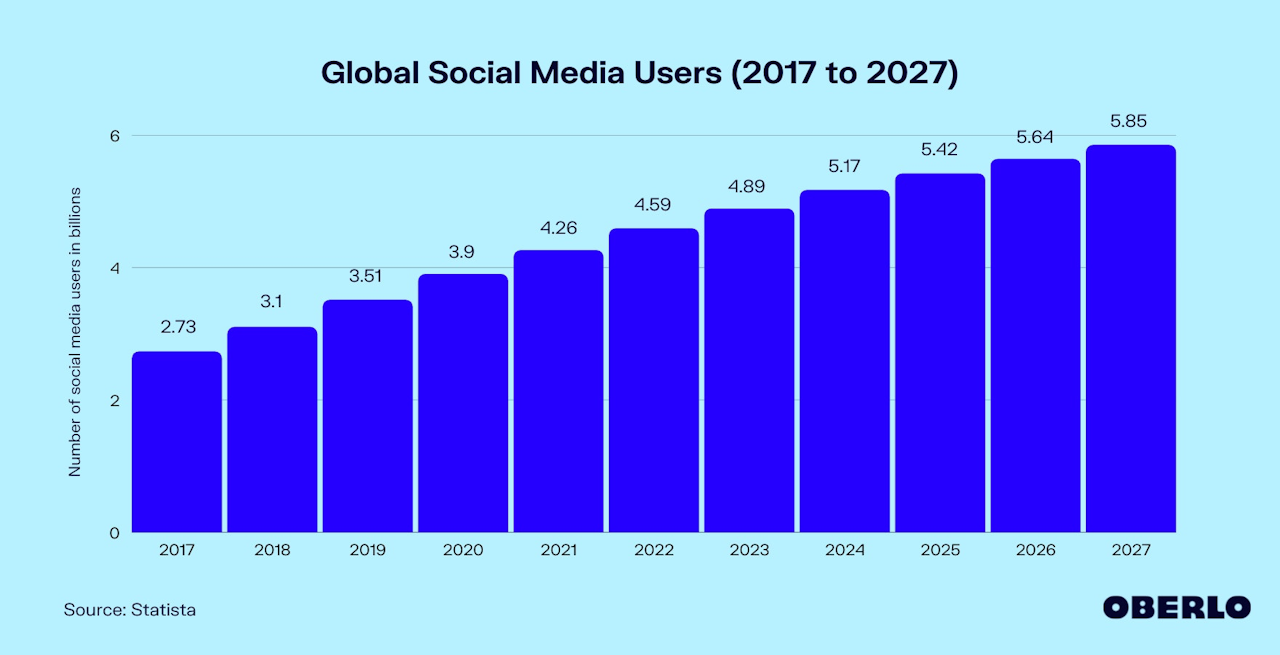
And it’s not just about quantity — social media is a great way to target highly qualified key accounts.
In fact, most marketers agree that the best way to improve lead quality is by using social selling tactics.
Social selling is so effective at generating high-quality leads because it’s largely a self-selecting group of people who visit your social media profile. More than likely, visitors to your page are interacting with your profile because they have at least some interest in your product or brand.
In other words, most leads are at least a little bit warm when they visit your page. This makes it easier (and more productive) to pursue each opportunity.
The Best Networks for Social Selling
Although it seems like more and more social media platforms pop up every day, there are four major players when it comes to B2B social selling: Twitter, Instagram, LinkedIn, and Facebook. 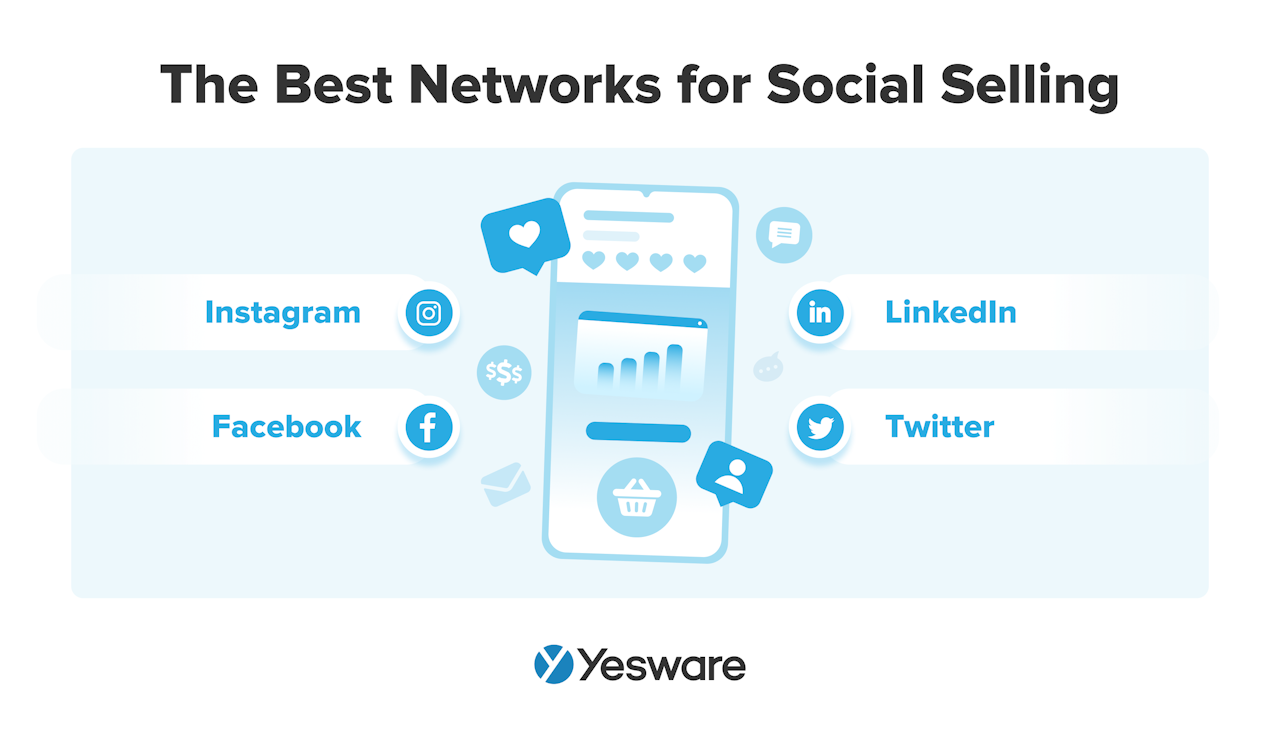
Though it’s currently in a time of transition, Twitter remains a popular hub for B2B sales opportunities.
The short-form news-sharing site makes it easy for marketers and sales reps to monitor, attract, and interact with buyers in a casual and authentic way in a wide variety of circumstances.
Instagram is another great platform for interacting more casually with B2B buyers.
Unlike Twitter, though, Instagram lets users feature pictures and videos alongside longer-form posts, making it a good forum for educational posts, infographics, video campaigns, product feature highlights, and other image-based content.
Instagram offers insights and analytics to its B2B users that they can use to help improve their social selling strategy for the platform.

LinkedIn is decidedly more formal than Instagram and Twitter, though certainly no less popular.
In fact, LinkedIn has seen remarkable, steady growth in its number of users for over 14 years and shows no sign of stopping — the number is now up to well over 900 million users in 2023.

Marketing professionals strongly agree that LinkedIn is a great tool for generating leads, with 89% reporting that they rely on the platform for prospecting and 62% reporting that it generates leads at twice the rate of other platforms.
Sales reps appreciate LinkedIn because of how easy the platform makes it to connect directly with B2B decision-makers; LinkedIn’s population is absolutely packed with high-level stakeholders and influential higher-ups.
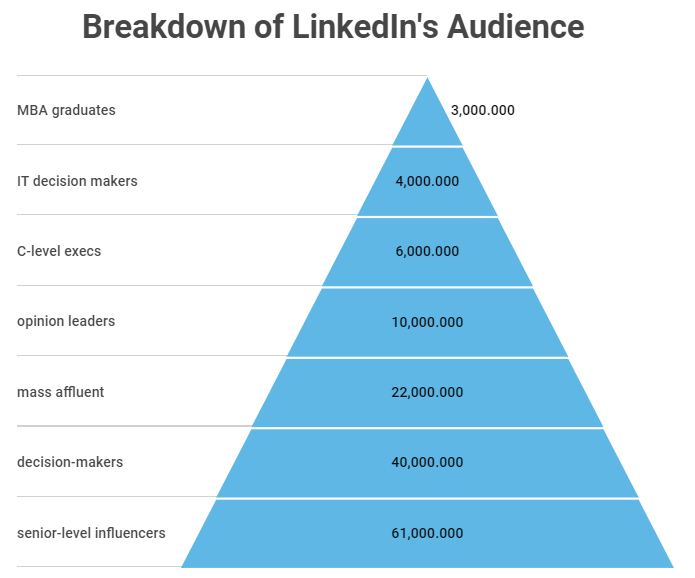
It’s important to keep in mind that, despite its abundance of B2B sales opportunities, LinkedIn is still a social network, and users expect authenticity and adherence to professional social norms.
In other words, don’t send mass, un-personalized connection requests or force rapport for the sake of pushing deals just because people are expecting you to do business on the platform. There are still social rules of engagement — some specific to LinkedIn — that sales reps need to mind.
Moving back to the more casual side of social media, Facebook is another widely-used platform with nearly 3 billion users worldwide.
B2B sellers love Facebook because the platform makes it easy to keep tabs on buyer needs through communities and groups related to the problem your product solves.
Facebook is also a very effective platform for sharing content. It allows for more in-depth discussion and interaction that isn’t always possible on other forums like Twitter and Instagram.
Many marketers also rely on Facebook for targeted paid ad campaigns as part of their inbound lead generation strategy.
Social Selling Strategies
Because social media is such a habitual part of our non-professional lives, it can be easy to fall into some of those casual habits when you’re utilizing a social selling approach.
Hopefully this goes without saying, but avoid at all costs conflating business social media with your personal platforms. Social selling on Facebook, Twitter, or LinkedIn calls for a different set of etiquette rules and best practices than those you probably follow while scrolling your profile at the end of a long day.
1. Be Human in Front-Facing Interactions
The point of social selling is to make real, genuine connections with potential customers. While it can be tempting to outsource social media tasks to chatbots or VAs, don’t do it. Nothing is more frustrating for a potential customer than getting stuck in an endless messaging loop with a mindless robot.
There are tons of automated tools that will boost your social selling skills (we’ll get to these in a minute), but save them for use cases where the customer won’t know they exist. Your sales reps and/or marketing team should handle any and all prospect interactions.
2. Automation Is Your Friend
While it’s important to log the real hours when it comes to customer conversation and content creation, there are many opportunities in social selling to leverage the power of automation.
For example, with Yesware’s LinkedIn Integration, you can connect with buyers without leaving your inbox:
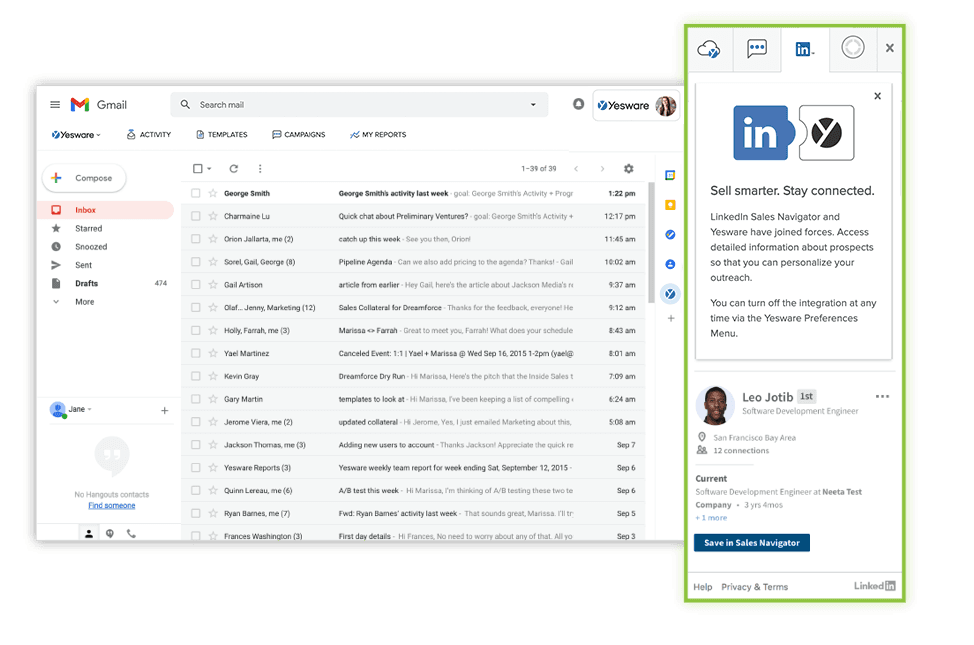 You can also seamlessly connect with prospects through LinkedIn in your Prospecting Campaigns.
You can also seamlessly connect with prospects through LinkedIn in your Prospecting Campaigns.

Automation tools can help you build relationships faster.
You should also explore the capabilities of your CRM. Many sales teams underutilize their CRM software. Go beyond the cookie-cutter functionality, and see what tools are under the surface.
The more you can automate and integrate behind the scenes, the more time and energy your sales team will have to offer above-and-beyond front-end value.
3. Build Your Brand
Your company’s brand should be cohesive and streamlined throughout your website and whatever social media platforms on which you have a presence.
Any savvy customer will be able to spot a Facebook profile that only exists to check a box. Your logo, the tone of your copy, and the overall feel of your platforms should be well-developed and consistent. This also adds to the brand trust you’ll build with your prospects.

Be sure to also go through and clean up any past posts, pictures, or interactions that don’t quite line up with your current messaging or customer-facing brand.
4. Know Your Place
One of the biggest benefits of social selling is that you get to leverage your “ins” a lot more easily than you do in the real world. When you’re working with a new prospect, look for any opportunity to reference an existing connection — people are much more likely to trust someone if they have a mutual contact.
It’s also important to prioritize your social media interactions; it’s unlikely that you’ll pay equal attention to each of the major platforms. Think about your customer and where they most likely spend their time, and focus your efforts there. Here are a few tips for each platform.
LinkedIn:
The key to social selling on LinkedIn? It’s all about your connections. Look for opportunities to connect through existing contacts or field-adjacent work. Craft your introduction message so that it’s personalized and offers value. Join any relevant LinkedIn Groups, too, and share content to add value where appropriate.
Twitter:
One feature we love about Twitter is Twitter Lists. Twitter Lists allow you to separate your followers behind the scenes, so you can further tailor your shared content and sales cadence based on who you’re talking to.
Facebook:
Facebook’s platform offers a great mix of business and casual, and it lends itself well to authentic, friendly interaction with other businesses and individuals. It’s easy to start a conversation, ask an open-ended question, or otherwise naturally engage with your followers and community.
Through all of these strategies, remember that the intention of social selling isn’t to make a sale; it’s to build real relationships that naturally lend themselves to sales opportunities.
Tip: Grab more data-backed social selling and outreach strategies below.
 Sales Engagement Data Trends from 3+ Million Sales ActivitiesLooking at millions of tracked email activity over the past few years, this ebook is filled with our top studies and findings to help sales teams accelerate results.
Sales Engagement Data Trends from 3+ Million Sales ActivitiesLooking at millions of tracked email activity over the past few years, this ebook is filled with our top studies and findings to help sales teams accelerate results.
How to Get Started Social Selling
The following steps will help you get started with social selling.
1. Optimize Your Profiles
The first step in any social selling strategy is to review your current social media profiles (or create them if you haven’t already).
Think carefully about how your profiles currently portray your brand. Is the public-facing information and content in line with your overall branding? Are your profiles consistent with one another? Do they give an air of trustworthiness and legitimacy?
If you’re updating a personal LinkedIn or Twitter profile, make sure you go beyond a basic job title and headline. Your real estate here is limited, so use compelling copy to describe clearly what you do and how you do it. Showcase your strengths, and give them merit by asking for endorsements or recommendations.
Also, ensure that all of the technical parts of your profile are up to snuff: use hashtags properly, make sure your images are high resolution, ensure your content is free of errors, etc.
2. Prospect and Connect
Once you’re confident that your profiles will make a great impression, it’s time to start connecting.
Each platform has its own tools for looking for, attracting, and researching prospects, so make sure your team is trained on how to use each of them.
Here are a handful of ways within each of the various platforms to discover new leads:
- LinkedIn Sales Navigator
- Sidebar
- Lead Builder
- LinkedIn Pulse
- Twitter Lists
- Facebook Groups
- Instagram Threads
Just remember — despite the seemingly faceless nature of most social media, buyers still expect personalization and relevance.
3. Build and Grow Your Network Through Content
One of the best things about social media is that it can help your audience grow very quickly with the right content in the right place with the right strategy.

Social media was built for sharing ideas, so as long as you position yourself correctly and create high-value content that’s easy to share and solves buyer problems, you should see quick traction in your reach.
4. Keep Things Relevant and Concise
As tempting as it is to tap into every corner of the market you find on social media, consider this a marathon, not a sprint.
Don’t send mass connection or friend requests, and definitely don’t send spammy, catch-all messages with no attempt at personalization. Buyers will see through this, and writing someone off (or even blocking them) on social media is a fast, ruthless, and sometimes irreversible process.
The same concept goes for content — make sure it’s on-topic, relevant, and only as long as it needs to be. That’s not to say that you should sell your expertise short, but long-windedness does not always equal high value. Respect your audience’s time, and try to use your content to drill down into their most pressing needs.
How to Optimize Your Social Profiles for Social Selling
A big part of executing a successful social selling strategy is ensuring you drive enough audience to your various platforms.
Each platform, of course, has its own “preferences” when it comes to which profiles they like to show their users in search results.
The following best practices will help organizations optimize their profiles so that prospects can easily see and interact with them.
When LinkedIn first launched, it served as a way for job-seekers to showcase their resumes and connect with employers.
Now, with over 810 million users in over 200 countries, it’s much more than that. It’s a full-blown professional social media platform where professionals from all industries can connect, share content and information, and offer their services and expertise to potential clients.
With so many users, though, it can be hard to know how to get your LinkedIn profile to stand out from the crowd. Here are a few ways to optimize your profile so that it’s easily discoverable and primed for your social selling strategy.
- Professionalize your picture: If you don’t already have a picture on your LinkedIn profile, add one — stat. Profiles with pictures are much more likely to show up in the platform’s search algorithm. They’re also more likely to garner responses from direct messages — LinkedIn reports a 40% better reply rate for profiles that have pictures.
- Add value to your headline: Your LinkedIn headline is arguably the most important real estate on your profile. It’s where you show visitors to your page what you do and what you’re all about. Use this space to demonstrate the value you or your brand can offer to potential customers. In other words, don’t just share what you do, share what you help others do when they work with your product.
- Use keywords in your summary: Your LinkedIn summary does some of the heavy lifting when it comes to getting your profile to display in searches. Use this space to include keywords that are relevant to your or your market’s industry. The summary section is short, so be concise and purposeful. The words you choose will be analyzed as Google and other search engines figure out where to place you in search results.
- Engage visually: If you have space available, you might consider including images or screenshots of visuals that help prospects understand what you do and the value you offer. Things like presentation slides and client performance improvement stats can go a long way in getting your message across.
- Include contact information: It’s always a good idea to include other ways to reach you outside of LinkedIn. Be sure to make visible your company website, email address, and phone number. You might also include links to your other social media profiles.
You should assume that your LinkedIn profile will be one of the first impressions you make on many prospects, so take the time to make sure it’s optimized.
Twitter is another social media platform that started with one intent — to share news and noteworthy information — but has since become a forum for social selling.
It’s also a platform that moves fast. You have only a few seconds to capture a visitor’s attention. Make it count by optimizing your profile.
- Banner image: One of the very first things a visitor to your Twitter profile will see is your banner image. This is the wide image that runs across the top of your page. It’s separate from your profile picture. Many sales reps choose to use their banner image to showcase their brand name, but it’s okay to get creative here if you want. You can change your banner frequently depending on what’s relevant in your company: new products, special offers or announcements, or upcoming events are all great content for the Twitter banner. In other words, put here anything that warrants the immediate attention of a visitor.
- Profile image: Your profile image also leaves some room for creativity. Unlike LinkedIn, it’s not a deal-breaker to not use a professional headshot. It’s okay to use that space for your company logo or other non-traditional profile pictures. Just make sure it’s relevant to your role or company, and that it fits the size constraints of Twitter’s profile picture space.
- Account name and Twitter handle: Make sure your account name and handle are easy to read, remember, and type. It’s also important to be clear and concise with these two profile components — if you’re a SaaS salesperson, your handle shouldn’t be @doglover88 (no matter how much you might really love dogs). Save the creativity for other sections.
- Location: Companies who focus on selling local should make sure to include their location on their Twitter profile. This will help it rank for local searches.
- Bio: Your Twitter bio should include keywords that are relevant to your industry or the industry of your target market. Some people choose to include hashtags in their bio — tread lightly here. They can be really effective, but there’s also the risk of using a keyword that’s a bit too generic for your industry — one that may lead prospects to discover some of your competitors. Try to use hashtags that are easy to understand, but unique enough to your offer that they keep people in your sphere.
- Pinned tweet: Pinning a tweet with your most important information, or with details about exciting promotions or events, is a great way to get the non-negotiables in front of visitors to your Twitter profile.
Effective Twitter use is a great way to show prospects that you are a thought leader in your industry and at the forefront of breaking market news and innovation.
Facebook is the most well-known and widely-used social media platform with nearly 3 billion monthly users. It goes without saying that any company that wants to leverage social selling needs to be on Facebook.
That being said, though, Facebook for business follows different rules than Facebook for staying in touch with college friends. The following tips will help you optimize your Facebook profile for effective social selling:
- Profile picture and cover photo: Just like Twitter, Facebook offers users two opportunities to display pictures or photos. Use these both to your advantage. Your profile, for the most part, should be a professional image of yourself. The banner image is good for your company logo or advertising upcoming company events or promotions.
- Custom URL: Facebook gives users a default URL, which is sometimes a jumbled mess of characters. Users can change that, though, and businesses in particular should take care to edit their URL to something manageably easy to remember and type.
- Description: Use the description field to write a short synopsis of your role at the company, or what the company does in general terms.
- Business contact info: Make sure you include other ways to reach you or your organization, including a professional email address and webpage. Some people choose not to include phone numbers — either way is fine, as most people’s initial contact will be via email. You might also include here links to other social media profiles, especially LinkedIn.
- Template & CTA: Facebook offers a variety of templates for users to choose from, each best-suited for a particular type of business. There are options, for example, for service-based businesses, product-based ones, and nonprofits. Choose the one that most closely meets your business needs. Similarly, make sure you tailor your CTA to fit exactly what you want your visitors to do. Don’t write “Buy Now,” for example, if the button links to your “About Us” page.
- Edit page tabs: Similarly, Facebook also allows users to edit the links on the sidebar. For many businesses, “Home,” “Groups,” etc. work well, but be aware that those can be edited if there are better titles for those links.
- Business story: Facebook accounts for businesses also have the option to add a “Business story.” This section is separate from the description, and allows users a bit more space to elaborate on their organization.

Use keywords relevant to your business and industry in this section to help your Facebook profile rank for related searches.
Best Practices for Social Selling On LinkedIn
Although LinkedIn has become a socially acceptable way to broker new business connections and deals, there are some rules of thumb when it comes to interacting on the platform.
Stay Connected
If you want your profile to appear to as many people as possible, it’s important to stay active on the platform.
Make connections with people you meet in a timely manner, and include a personal note when you send the request. Actively and regularly study your network and mutual connections to see who’s entering your professional sphere and how you might be able to help them.
Add a Follow Button
LinkedIn offers users the option to let people “follow” your profile instead of making a more formal connection. Go to Settings to enable this option so that people can stay passively connected to you and your content without the pressure.
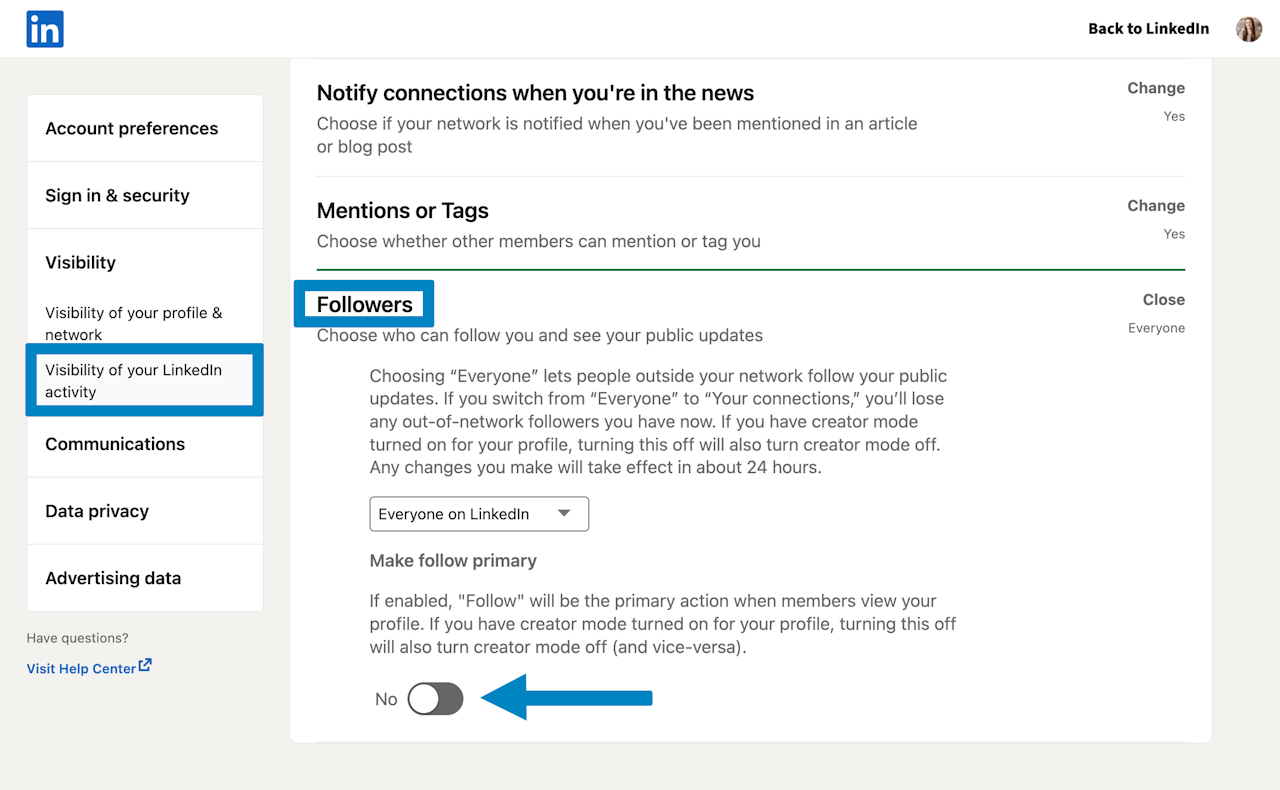
Stay On Top of Your Social Selling Index
Fortunately, LinkedIn has its own way of letting users know how effectively they’re using the platform to make connections and deals. Your Social Selling Index shows how well, according to LinkedIn’s algorithm, you establish your brand, find the right people, engage, and build relationships. Here’s what it looks like:

Check this score frequently and optimize as needed.
Don’t Use LinkedIn to Sell
Despite how easy and tempting it is, do not use LinkedIn to sell directly to prospects.
Your profile is not meant to give you cover while you push your product on the masses. It’s meant to be a tool to leverage connections and start conversations; save the selling for scheduled opportunities when you can dive into value-driven sales conversations.
Best Practices for Social Selling On Twitter
Just like LinkedIn, Twitter has its own rules of thumb when it comes to interacting with prospects and clients on the platform.
Be an Open Book
First thing’s first — make sure your profile is public and your inbox is open to DMs. While it’s true you might encounter spam or irrelevant messages, you risk losing far too many engagements if your profile is private or not accepting DMs.
Use Twitter Lists
One of Twitter’s coolest features for salespeople is the ability to sort followers into groups. Sales reps can use this to tailor their messaging based on the content that resonates most with each group.
Users can sort followers into Twitter Lists based on job title, location, company, or people they’ve met in person.
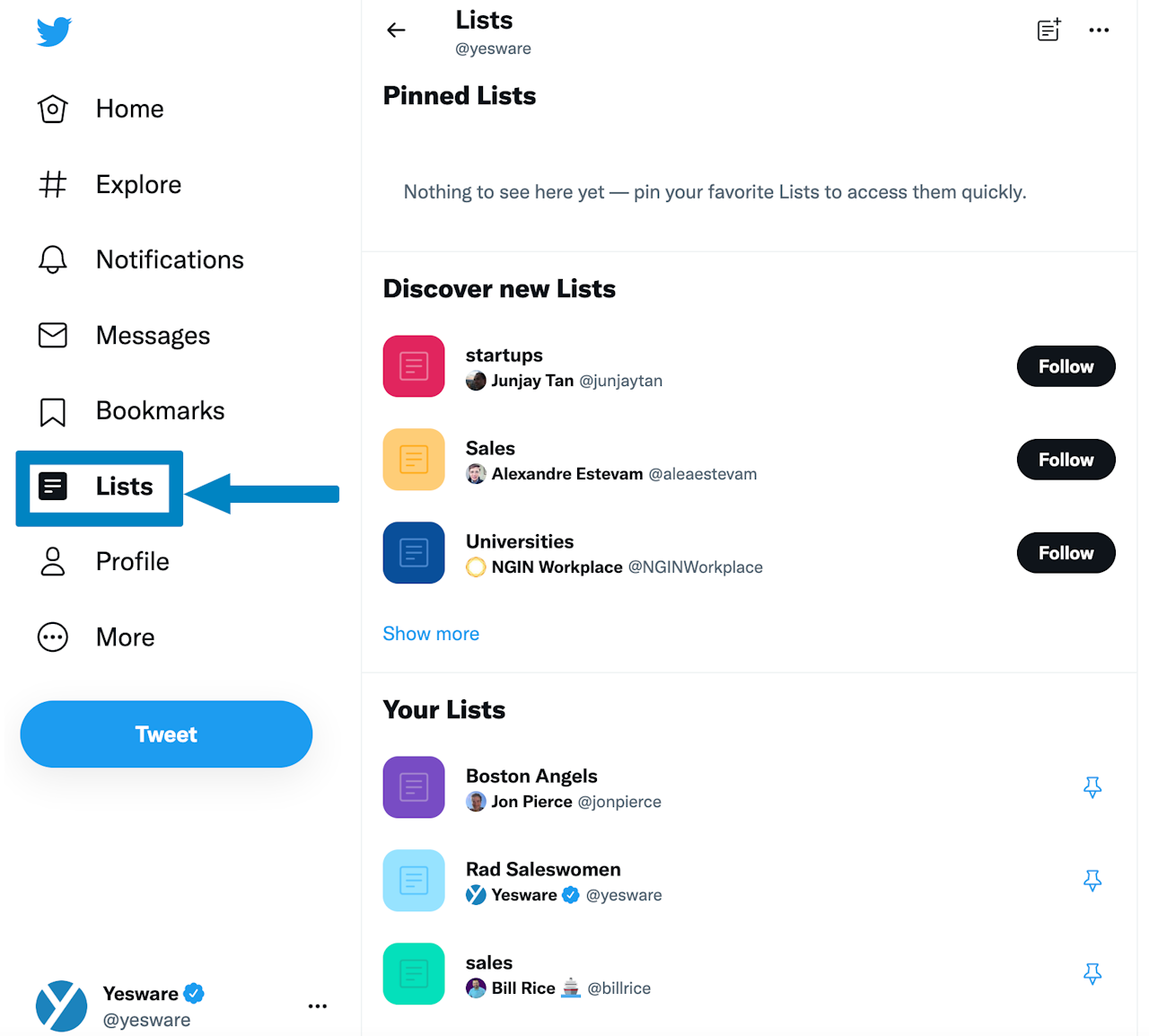
Tweet Value
While Twitter is sometimes considered a news-sharing platform, at least some of your Tweets should be value-based and drive conversation. Share content from your own organization, as well as others in your industry. This will help you appear up-to-date on the industry as a whole.
It’s also worth prioritizing rich media — Twitter research shows that posts with pictures and videos have 313% higher engagement than text-only ones. The character trade-off for using rich media can be worth it on the right posts.
Set a Schedule
Twitter users naturally gain more followers the more they post and use hashtags. Create a strategy that includes Tweeting at least once a day. According to Buffer, the most popular time to tweet is between noon and 1:00 p.m. And the tweets that earn the most clicks are between 2:00 and 3:00 am. Make sure your strategy includes off-hours posting.
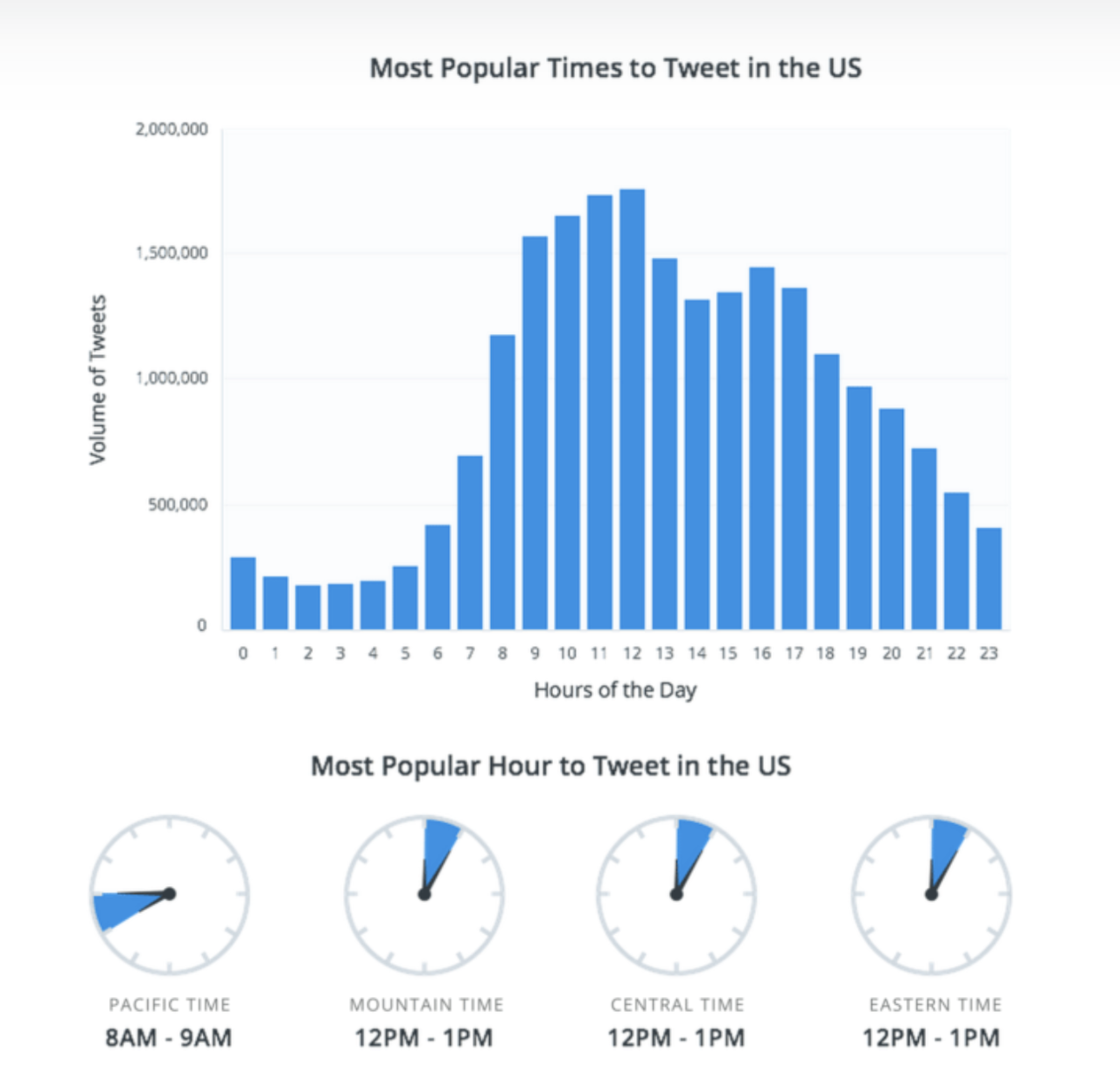
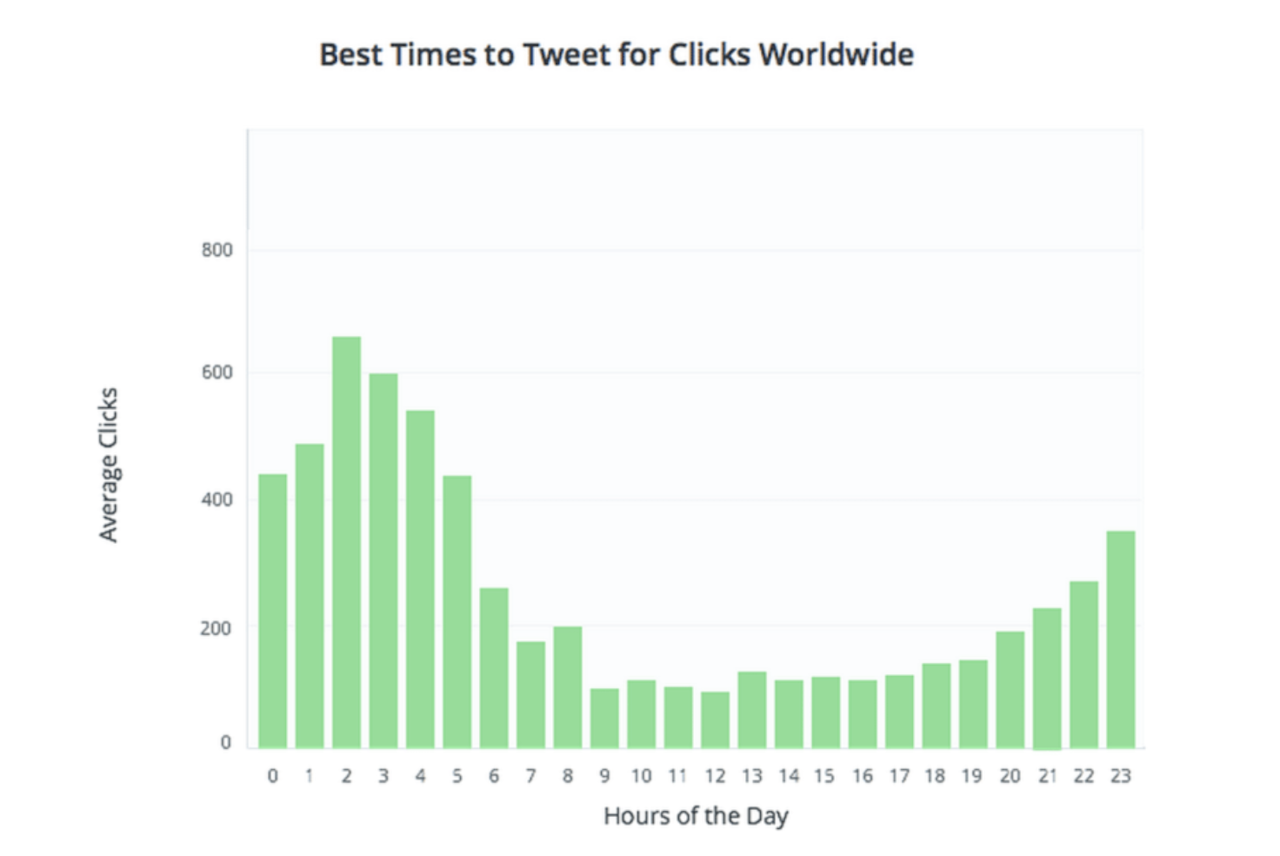
It’s also important to promptly and consistently respond to people who Tweet at you or who interact with your posts.
Don’t Use Twitter to Sell
Just like LinkedIn, Twitter is not the place to sell your product or service. Twitter should be used as an engagement tool that creates the right conditions for prospects to agree to sales conversations. No matter how short your elevator pitch is, Twitter isn’t the forum for it.
Best Practices for Social Selling On Facebook
Anyone who’s ever gone down the black hole of comments on a contentious Facebook post knows that the platform can seem lawless.
Still, it’s important for businesses to keep in mind that it shouldn’t be a free-for-all. Facebook for businesses should stick to some ground rules to keep the tone positive and productive for everyone.
Post Once or Twice a Day
The Facebook algorithm will get more eyes on your profile if you make it a goal to post at least once or twice a day.
It’s also important to make sure you’re sharing a variety of content — not just your own. Share thought pieces from other industry leaders and innovators. Encourage conversation around products and ideas that are not your own. Not only does this help the algorithm, but it also shows prospects that you’re in it for more than just the sale.
Use Facebook Insights & Analytics
Facebook actually has a pretty robust analytics feature. Sales reps and managers can use this tool to help them understand which content and outreach strategies are resonating most with their audience to further optimize their strategy.
Like and Respond to All Comments
Facebook is a platform for starting conversations — but don’t stop there. Any time you have engagement on one of your posts, use it to actually engage: like or react to all comments and respond whenever possible.
To that end, you’re also on the hook for responding to negative or unconstructive feedback. Don’t take the easy route by blocking or hiding less-than-glowing comments. Engage constructively and show the other prospects watching that you know how to face problems head-on.
Don’t Use Facebook to Sell
You may have guessed our last rule of thumb based on what we’ve shared about the other platforms: don’t use Facebook to sell your product.
Now, the Facebook platform makes this particular rule a bit more blurry due to their paid ad feature. Some businesses do find success using Facebook ads — we’re not suggesting you rule that out. But they serve a specific time and place. Outside of ad space, your business Facebook profile is not the time to push product.
Instead, aim to make most of your posts organic thought-leadership style posts that encourage conversation and consideration. Facebook’s algorithm rewards users who publish content that keep people on their platform — too many paid ads that ask people to click away from Facebook won’t get as many eyes as a healthy mix of conversation starters and promotional material.
How to Measure Social Selling Success
Because social selling is relatively new to the sales scene, tracking and measuring its efficacy is still somewhat of a moving target.
It’s also relatively subjective depending on a number of factors, including an organization’s specific goals, the needs of their target market, the age of their business, and many more.
Adding to that challenge is the fact that momentum and success in social selling tend to ebb and flow; progress is not always linear, which can make it feel difficult to keep tabs on the big picture.
For the time being, there’s no specific formula or framework for measuring the effectiveness of your team’s social selling strategy (unless you’re a paid LinkedIn Sales Navigator Premium member — more on that in the next section). But you can still track engagement statistics and close rates by adding a “Social” source to your CRM.
Social Selling Index
LinkedIn has developed their own internal measure for how effective an organization is at positioning themselves on the platform. They call this tool the “Social Selling Index” (SSI).
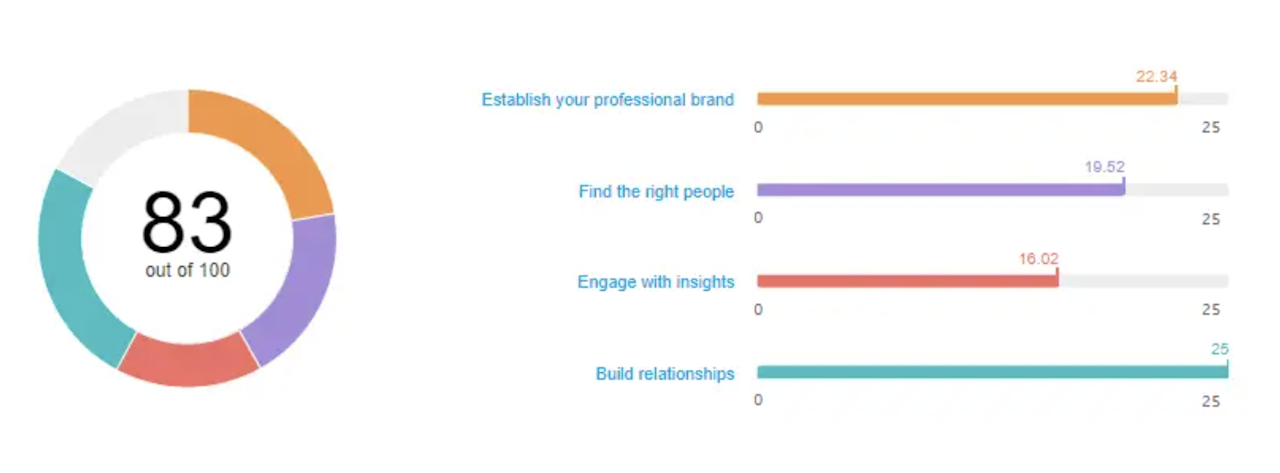
The SSI measures four main criteria, each given a score out of 25 for a total maximum score of 100.
- How optimized your profile is, aka how well it depicts your brand
- How well you connect with good-fit prospects
- The relevance of and engagement with your content
- The strength of your relationships with your connections
The SSI is updated daily on the Social Selling Dashboard.
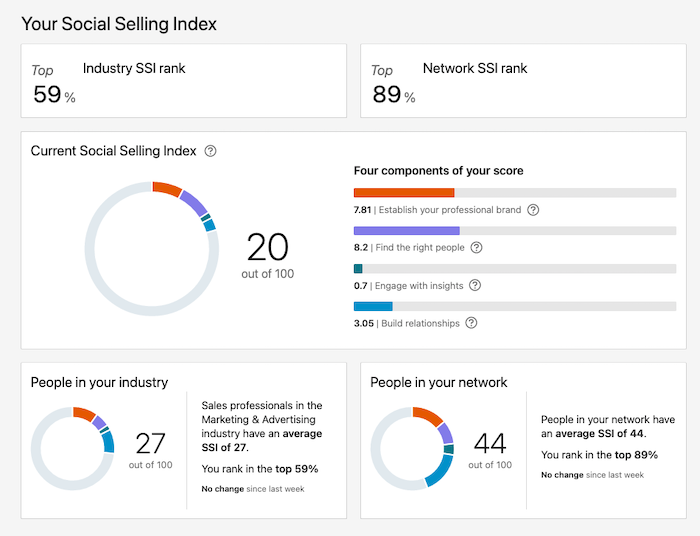
The Social Selling Index is currently only available to LinkedIn users who pay for a Sales Navigator Premium account.
Tools for Social Selling
There are many tools on the market to help you engage in social selling the right way. As with any sales strategy, make sure you’re meeting the buyer where they are in their journey.
1. Prospecting
Tools like Yesware’s LinkedIn Integration can help you connect with more prospects by incorporating social touches into your outreach campaigns and connect/message/research leads right from your inbox.
2. Sales Cadence
Social listening — a key component of social selling — is when a company monitors the posts, interests, and other social media activity of potential clients. They use this intel to tailor their marketing efforts. Social listening helps a sales rep identify the right time to enter a prospect’s buying journey. As well as the right content to bring to the job. Tools like Awario can help you find and join important conversations about your field in real time.
3. Content
Sharing content is another huge part of social selling, but organizing the moving pieces of writing, optimizing, and sharing content on a regular schedule can be daunting. Software like Hootsuite streamlines this process for you and can distribute (and track the analytics of) your content across various social media channels.
4. CRM
Juggling all of your contacts and connections — and where you stand with each of them in the sales process — can also be difficult to manage for busy sales professionals. Try tools like Yesware to help you skip the manual data entry and sync all activity to your CRM.
Social Selling Mistakes to Avoid
Although it can be a powerful tool, social selling is also full of potential missteps. Avoid the following social selling mistakes as you develop and optimize your strategy.
Treating Your Profile as a Sales Machine
While it’s true that social selling can be extremely lucrative, marketers and sales reps should take care to not treat their social media pages like money-grabbing promotional ads.
The profiles interacting with your business have real people behind them, and connection still counts — a lot.
Rather than treat it like a get-rich-quick tool, leverage the power of social media to build and strengthen the kinds of relationships that ultimately lead to sales.
Remember: value first, sale second.
Failing to Create a System
Social selling is fast-paced and has many moving pieces. It can get complex in a hurry if you aren’t careful about creating a system to track and manage it.
Sales and marketing should work together to create a content calendar and align on how, when, and where to track social selling data.

Neglecting Training
Some teams make the mistake of diving into social selling without any formal training, because they assume they already know everything they need to know about how to navigate social media. This is a recipe for failure.
B2B social selling skills and techniques require much more than the minimal tech-savviness required for personal social media use. Social selling done right relies on a consistent, team-wide, data-driven approach to developing your brand and marketing your offers on your various platforms.
This is important for a few reasons:
- Teams who use social selling without proper training waste resources.
- It can be hard to reverse circumstances when you inadvertently give visitors to your page an unfavorable impression.
- Your digital footprint lasts forever. A social media faux pas due to lack of training can be disastrous and, in some cases, permanent.
It’s also important that training and/or coaching is ongoing as you analyze and optimize your success.
Participating Carelessly
Social media can be a very reactive place. It’s easy for users — personal or professional — to be thoughtless when they type a question, comment, or response. Be very mindful of this and work to mitigate it.
One of the best parts of social selling is that, unlike something like a cold call, sellers usually have time to formulate a strategic response to those engaging with you. Make sure you take advantage of that planning time and put thought into each of your interactions.
This guide was updated on August 22, 2023.
Get sales tips and strategies delivered straight to your inbox.
Yesware will help you generate more sales right from your inbox. Try our Outlook add-on or Gmail Chrome extension for free, forever!
Related Articles
Casey O'Connor
Melissa Williams
Anya Vitko
Sales, deal management, and communication tips for your inbox

